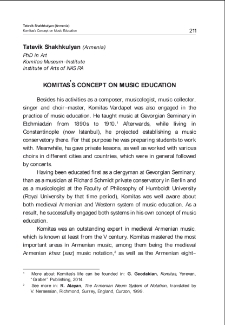Object
Title: Komitas’s Concept on Music Education
Journal or Publication Title:
Կոմիտասի թանգարան-ինստիտուտի տարեգիրք = Komitas museum-institute yearbook
Date of publication:
Volume:
ISBN:
Additional Information:
Other title:
Երաժշտական կրթության Կոմիտասի հայեցակարգը
Contributor(s):
Abstract:
Կոմիտասի բազմակողմանի գործունեության մեջ առանձին տեղ է զբաղեցնում մանկավարժական աշխատանքը ։ Նա երաժշտություն էր դասավանդում Էջմիածնի Գևորգյան ճեմարանում ։ Ծրագրել էր Կոստանդնուպոլսում հիմնել կոնսերվատորիա, և այդ նպատակով աշակերտներ էր պատրաստում ։ Նրա հայեցակարգը հիմնված էր դասավանդման դասական (արևմտաեվրոպական և ռուսական) և ազգային ավանդական (ժողովրդական և հոգևոր երաժշտության վրա հիմնվող) սկզբունքների համակցման վրա։ Կոմիտասի երաժշտության տեսության, հարմոնիայի և պատմության դասագրքերը հնարավորություն են տալիս հասկանալու նրա մոտեցումները ։ Կոմիտասը երաժշտության տեսություն էր դասավանդում հայկական նոտագրության հիման վրա, ոչ թե եվրոպականի, թեև հրաշալի տիրապետում էր թե՛ մեկին, թե՛ մյուսին ։ Ինչո՞ւ էր Կոմիտասը հիմնվում հայկական նոտագրության վրա։ Ինչպե՞ս է այն առնչվում հայ երաժշտության հնչյունաշարերի կոմիտասյան տեսությանը, որի հիմքում ոչ թե հարևան, այլ կցվող տետրախորդների սկզբունքն է: Հոդվածում անդրադառնում ենք այս հարցերին և քննարկում կոմիտասյան դասագրքերի բովանդակային և կառուցվածքային որոշ առանձնահատկություններ։
Music pedagogy occupies an important place in Komitas’s multi–dimensional activity. He was a music teacher at Gevorgian Seminary in Etchmiadzin. Founding a conservatory in Costantinople was among his fundamental projects, and for that purpose he was preparing students to work with. In the basis of Komitas’s concept on music education laid the idea of juxtaposing from the one hand, the elements of Western classical pedagogy and, from the other hand, the national traditional principles of didactics. Komitas’s textbooks on music theory, harmony and music history allow understanding the system of Komitas’s approach in music education. Komitas used to teach music theory based on Armenian notation, rather than the Western one, although he himself perfectly possessed both of them. Why did Komitas use Armenian notation? It was Komitas to invent that conjunct rather than disjunct tetrachords laid in the basis of Armenian traditional music. Are there any relations between priority of Armenian notation by Komitas and Armenian music modes? In the article, I focuse on those questions and discuss the content and structure of Komitas’s textbooks.
Table of contents:
ԳԼՈՒԽ Դ. Երաժշտական կրթություն
CHAPTER IV: Music Education
Place of publishing:
Երևան
Publisher:
Format:
Extent:
Identifier:
oai:arar.sci.am:270859
General note:
Object collections:
Last modified:
Dec 24, 2021
In our library since:
Jun 10, 2021
Number of object content hits:
214
All available object's versions:
https://arar.sci.am/publication/295132
Show description in RDF format:
Show description in OAI-PMH format:
-
Կոմիտասի թանգարան-ինստիտուտի տարեգիրք = Komitas museum-institute yearbook
-
Կոմիտասի թանգարան-ինստիտուտի տարեգիրք: Հատոր Ա. Կոմիտասը և միջնադարյան երաժշտական մշակույթը
-
Կոմիտասի թանգարան-ինստիտուտի տարեգիրք: Հատոր Բ․ Կոմիտասը և ավանդական երաժշտական մշակույթը
-
Կոմիտասի թանգարան-ինստիտուտի տարեգիրք: Հատոր Գ
-
Կոմիտասի թանգարան-ինստիտուտի տարեգիրք: Հատոր Դ
- Կազմ; Խմբագրական
- Բովանդակություն; Content
- Նախաբանի փոխարեն
- Komitas’s National Musical Identity Paradigm and Armenian Bard Tradition
- Комитас Вардапет — основоположник армянской музыкальной медиевистики
- Komitas Vardapet (Archimandrite) et l’art Français
- Claude Debussy et Komitas Vartabet
- The Theoretical Basis of Komitas’s Concept Concerning Armenian Secular and Sacred Music
- Մարգարիտ Բաբայանը՝ տարբեր ազգերի ժողովրդական երգերի մեկնաբան
- Ավանդական երաժշտության հավաքչական աշխատանքները Կոմիտասից մինչև մեր օրերը
- Հայ ժողովրդական վիպերգ «Վո՜ւյ Ալեքսան»
- Հայկական օրորների «կայուն» ենթաճյուղը XIX դարի վերջից մինչև XX դարի առաջին կեսն արված գրառումներում
- Շումերական էպոսը և հայկական ժողովրդական ավետիսները
- Որոշ դիտարկումներ Ալեքսանդրապոլի աշուղական համքարության երգային ժառանգության շուրջ
- Armenian Musical Instruments: Three Etymologies
- Creativity from the Beginning: the Principles of “Orff–Schulwerk”
- Komitas’s Concept on Music Education
-
Կոմիտասի թանգարան-ինստիտուտի տարեգիրք: Հատոր Ե․ Կոմիտասը և իր ժառանգությունը
-
Կոմիտասի թանգարան-ինստիտուտի տարեգիրք: Հատոր Զ․
-
Կոմիտասի թանգարան-ինստիտուտի տարեգիրք: Հատոր Է․
-
Կոմիտասի թանգարան-ինստիտուտի տարեգիրք: Հատոր Թ․
-
Կոմիտասի թանգարան-ինստիտուտի տարեգիրք: Հատոր Ա. Կոմիտասը և միջնադարյան երաժշտական մշակույթը
| Edition name | Date |
|---|---|
| Shakhkulyan, Tatevik, Komitas’s Concept on Music Education | Dec 24, 2021 |





